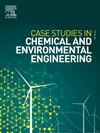Oil palm biomass ash removal for boiler fuel optimization: A case study
Q1 Environmental Science
Case Studies in Chemical and Environmental Engineering
Pub Date : 2024-12-06
DOI:10.1016/j.cscee.2024.101049
引用次数: 0
Abstract
The growing demand for sustainable energy sources has prompted increased interest in biomass materials, particularly oil palm biomass (OPB), as an alternative to coal for power generation. OPB, derived from oil palm plantations, is abundant in tropical regions and represents a renewable energy resource. However, its high alkali content presents challenges in the form of slagging and fouling in boilers, which can lead to operational inefficiencies and equipment damage. This issue hinders the broader adoption of OPB in energy production, which is crucial for meeting global energy demands while addressing environmental concerns. In this study, OPB particles (<0.86 mm) underwent a 15-min washing treatment using acetic acid and water at a solid-to-liquid ratio of 1:15 to mitigate slagging and fouling risks. Various OPB types, including empty fruit bunches (EFB), shells (SHL), fibers (FBR), fronds (FRD), and trunks (TRK), were examined. The results showed that acetic acid washing removed 44–78 % of the ash content and increased the ash fusion temperature (AFT) by 8.8–14.8 %, compared to 32–50 % ash removal and a 4.2–7.6 % AFT rise with water washing. Both treatments effectively reduced slagging and fouling tendencies, making OPB a more viable and environmentally sustainable alternative for power generation.
油棕生物质除灰锅炉燃料优化:一个案例研究
对可持续能源日益增长的需求促使人们对生物质材料,特别是油棕生物质(OPB),作为煤炭发电的替代品的兴趣增加。产自油棕种植园的OPB在热带地区储量丰富,是一种可再生能源。然而,它的高碱含量给锅炉带来了结渣和结垢的挑战,这可能导致运行效率低下和设备损坏。这一问题阻碍了在能源生产中更广泛地采用OPB,这对于满足全球能源需求同时解决环境问题至关重要。在本研究中,OPB颗粒(0.86 mm)以1:15的固液比,用乙酸和水进行15分钟的洗涤处理,以减轻结渣和结垢的风险。研究了各种OPB类型,包括空果束(EFB)、壳(SHL)、纤维(FBR)、叶子(FRD)和树干(TRK)。结果表明:醋酸洗涤可去除44 ~ 78%的灰分,提高8.8 ~ 14.8%的灰分熔融温度(AFT),而水洗可去除32 ~ 50%的灰分,提高4.2 ~ 7.6%的AFT。这两种处理方法都有效地减少了结渣和结垢的趋势,使OPB成为一种更可行、更环保的发电替代方案。
本文章由计算机程序翻译,如有差异,请以英文原文为准。
求助全文
约1分钟内获得全文
求助全文
来源期刊

Case Studies in Chemical and Environmental Engineering
Engineering-Engineering (miscellaneous)
CiteScore
9.20
自引率
0.00%
发文量
103
审稿时长
40 days
 求助内容:
求助内容: 应助结果提醒方式:
应助结果提醒方式:


